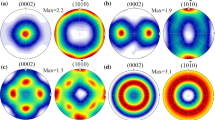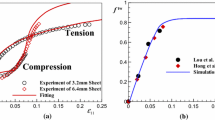Abstract
The recently developed elastic-viscoplastic self-consistent model with various self-consistent schemes was applied to study the effect of basal texture on the mechanical behavior of magnesium alloy AZ31B sheet. The influence of the basal texture was investigated using various initial textures generated by artificially tilting the measured texture of the reference AZ31B sheet around in a transverse direction. The material parameters for the various models were fitted to experimental uniaxial tension and compression along the rolling direction and were then used to study the effects of the basal texture on the yield stress, R value, ultimate stress and uniform strain under uniaxial tension. The effect of the basal texture on sheet metal forming was further assessed by calculating the limit strain under in-plane plane strain tension. An assessment of the predictive capability of polycrystal plasticity models was made based on comparisons of predictions and experimental observations. Among the available self-consistent approaches, the Affine self-consistent scheme resulted in the best overall performance.
Similar content being viewed by others
References
Agnew, S.R., Duygulu, O., 2005. Plastic anisotropy and the role of non-basal slip in magnesium alloy AZ31B. International Journal of Plasticity, 21(6):1161–1193. [doi:10.1016/j.ijplas.2004.05.018]
Agnew, S.R., Horton, J.A., Lillo, T.M., Brown, D.W., 2004. Enhanced ductility in strongly textured magnesium produced by equal channel angular processing. Scripta Materialia, 50(3):377–381. [doi:10.1016/j.scriptamat.2003.10.006]
Anand, L., Kalidindi, S.R., 1994. The process of shear band formation in plane strain compression of fcc metals: effects of crystallographic texture. Mechanics of Materials, 17(2–3):223–243. [doi:10.1016/0167-6636(94)90062-0]
Asaro, R.J., Needleman, A., 1985. Texture development and strain hardening in rate dependent polycrystals. Acta Metallurgica et Materialia, 33:923–953.
Avery, D.H., Hosford, W.F., Backofen, W.A., 1965. Plastic anisotropy in magnesium alloy sheets. Transactions of the Metallurgical Society of AIME, 233:71–78.
Barlat, F., Yoon, J.W., Cazacu, O., 2007. On linear transformation based anisotropic yield functions. International Journal of Plasticity, 23(5):876–896. [doi:10.1016/j.ijplas.2006.10.001]
Beyerlein, I.J., Tomé, C.N., 2010. A probabilistic twin nucleation model for HCP polycrystalline metals. Proceedings of the Royal Society A: Mathematical Physical & Engineering Sciences, 466(2121):2517. [doi:10.1098/rspa.2009.0661]
Chino, Y., Sassa, K., Mabuchi, M., 2008. Enhancement of tensile ductility of magnesium alloy produced by torsion extrusion. Scripta Materialia, 59(4):399–402. [doi:10.1016/j.scriptamat.2008.04.013]
del Valle, J.A., Ruano, O.A., 2009. Effect of annealing treatments on the anisotropy of a magnesium alloy sheet processed by severe rolling. Materials Letters, 63(17): 1551–1554. [doi:10.1016/j.matlet.2009.04.014]
Eshelby, J.D., 1957. The determination of the elastic field of an ellipsoidal inclusion, and related problems. Proceedings of the Royal Society of London. Series A, Mathematical and Physical Sciences, 241(1226):376–396.
Hartig, Ch., Styczynski, A., Kaiser, F., Letzig, D., 2005. Plastic anisotropy and texture evolution of rolled AZ31 magnesium alloys. Materials Science Forum, 495–497: 1615–1620. [doi:10.4028/www.scientific.net/MSF.495-497.1615]
Huang, X.S., Suzuki, K., Watazu, A., Shigematsu, I., Saito, N., 2008. Mechanical properties of Mg-Al-Zn alloy with a tilted basal texture obtained by differential speed rolling. Materials Science and Engineering: A, 488(1–2): 214–220. [doi:10.1016/j.msea.2007.11.029]
Hutchinson, J.W., 1976. Bounds and self-consistent estimates for creep of polycrystalline materials. Proceedings of the Royal Society of London. Series A, Mathematical and Physical Sciences, 348(1652):101–127.
Jain, A., Agnew, S.R., 2007. Modeling the temperature dependent effect of twinning on the behavior of magnesium alloy AZ31B sheet. Materials Science and Engineering: A, 462(1–2):29–36. [doi:10.1016/j.msea.2006.03.160]
Kaiser, F., Letzig, D., Bohlen, J., Styczynski, A., Hartig, Ch., Kainer, K.U., 2003. Anisotropic properties of magnesium sheet AZ31. Materials Science Forum, 419-422:315–320. [doi:10.4028/www.scientific.net/MSF.419-422.315]
Kalidindi, S.R., 2001. Modeling anisotropic strain hardening and deformation textures in low stacking fault energy fcc metals. International Journal of Plasticity, 17(6):837–860. [doi:10.1016/S0749-6419(00)00071-1]
Lebensohn, R.A., Tomé, C.N., 1993. A self-consistent anisotropic approach for the simulation of plastic deformation and texture development of polycrystals: Application to zirconium alloys. Acta Metallurgica et Materialia, 41(9): 2611–2624. [doi:10.1016/0956-7151(93)90130-K]
Lebensohn, R.A., Turner, P.A., Signorelli, J.W., Canova, G.R., Tomé, C.N., 1998. Calculation of intergranular stresses based on a large strain visco-plastic self-consistent model. Modelling and Simulation in Materials Science and Engineering, 6(4):447–465. [doi:10.1088/0965-0393/6/4/011]
Lebensohn, R.A., Dawson, P.R., Kern, H.M., Wenk, H.R., 2003. Heterogeneous deformation and texture development in halite polycrystals: comparison of different modeling approaches and experimental data. Tectonophysics, 370(1–4):287–311. [doi:10.1016/S0040-1951(03)00192-6]
Lebensohn, R.A., Tomé, C.N., Castañeda, P.P., 2007. Self-consistent modeling of the mechanical behavior of viscoplastic polycrystals incorporating intragranular field fluctuations. Philosophical Magazine, 87(28):4287–4322. [doi:10.1080/14786430701432619]
Lou, X.Y., Li, M., Boger, R.K., Agnew, S.R., Wagoner, R.H., 2007. Hardening evolution of AZ31B Mg sheet. International Journal of Plasticity, 23(1):44–86. [doi:10.1016/j.ijplas.2006.03.005]
MacEwen, S.R., Tomé, C., Faber, J., 1989. Residual-stresses in annealed zircaloy. Acta Metallurgica, 37(3):979–989. [doi:10.1016/0001-6160(89)90025-4]
MacEwen, S.R., Christodoulou, N., Salinasrodriguez, A., 1990. Residual grain-interaction stresses in zirconium alloys. Metallurgical Transactions, 21A:1083–1095.
Marciniak, Z., Kuczynski, K., 1967. Limit strains in the process of stretch-forming sheet metal. International Journal of Mechanical Sciences, 9(9):609–620. [doi:10.1016/0020-7403(67)90066-5]
Molinari, A., Tóth, L.S., 1994. Tuning a self-consistent viscoplastic model by finite element results. Part I: Modeling. Acta Metallurgica et Materialia, 42(7):2453–2458. [doi:10.1016/0956-7151(94)90324-7]
Molinari, A., Canova, G.R., Ahzi, S., 1987. A self-consistent approach of the large deformation polycrystal viscoplasticity. Acta Metallurgica, 35(12):2983–2994. [doi:10.1016/0001-6160(87)90297-5]
Mukai, T., Yamanoi, M., Watanabe, H., Higashi, K., 2001. Ductility enhancement in AZ31 magnesium alloy by controlling its grain structure. Scripta Materialia, 45(1): 89–94. [doi:10.1016/S1359-6462(01)00996-4]
Muransky, O., Carr, D.G., Barnett, M.R., Oliver, E.C., Sittner, P., 2008. Investigation of deformation mechanisms involved in the plasticity of AZ31 Mg alloy: in situ neutron diffraction and EPSC modelling. Materials Science and Engineering: A, 496(1–2):14–24. [doi:10.1016/j.msea.2008.07.031]
Proust, G., Tomé, C.N., Jain, A., Agnew, S.R., 2009. Modeling the effect of twinning and detwinning during strain-path changes of magnesium alloy AZ31. International Journal of Plasticity, 25(5):861–880. [doi:10.1016/j.ijplas.2008.05.005]
Shi, Y., Wu, P.D., Lloyd, D.J., Embury, J.D., 2010. Crystal plasticity based analysis of localized necking in aluminum tube under internal pressure. European Journal of Mechanics A/Solids, 29(4):475–483. [doi:10.1016/j.euromechsol.2010.03.005]
Staroselsky, A., Anand, L., 1998. Inelastic deformation of F.C.C. materials by slip and twinning. Journal of the Mechanics and Physics of Solids, 46(4):671–696. [doi:10.1016/S0022-5096(97)00071-9]
Taylor, G.I., 1938. Plastic strain in metals. Journal of the Institute of Metals, 62:307–324.
Tomé, C.N., 1999. Self-consistent polycrystal models: a directional compliance criterion to describe grain interactions. Modeling and Simulation in Material Science Engineering, 7(5):723–738. [doi:10.1088/0965-0393/7/5/305]
Tomé, C.N., Lebensohn, R.A., Kocks, U.F., 1991. A model for texture development dominated by deformation twinningapplication to zirconium alloys. Acta Metallurgica et Materialia, 39(11):2667–2680. [doi:10.1016/0956-7151(91)90083-D]
Wang, H., Wu, P.D., Tomé, C.N., Huang, Y., 2010a. A finite strain elastic-viscoplastic self-consistent model for polycrystalline materials. Journal of the Mechanics and Physics of Solids, 58(4):594–612. [doi:10.1016/j.jmps.2010.01.004]
Wang, H., Raeisinia, B., Wu, P.D., Agnew, S.R., Tomé, C.N., 2010b. Evaluation of self-consistent crystal plasticity models for magnesium alloy AZ31B sheet. International Journal of Solids and Structures, 47(21):2905–2917. [doi:10.1016/j.ijsolstr.2010.06.016]
Wang, H., Wu, P.D., Gharghouri, M.A., 2010c. Effects of basal texture on mechanical behaviour of magnesium alloy AZ31 sheet. Materials Science and Engineering: A, 527(15):3588–3594. [doi:10.1016/j.msea.2010.02.050]
Wu, P.D., Neale, K.W., van der Giessen, E., 1997. On crystal plasticity FLD analysis. Proceedings of the Royal Society of London. Series A, Mathematical, Physical and Engineering Sciences, 453(1964):1831–1848. [doi:10.1098/rspa.1997.0099]
Wu, P.D., Neale, K.W., van der Giessen, E., Jain, M., Makinde, A., MacEwen, S.R., 1998. Crystal plasticity forming limit diagram analysis of rolled aluminum sheets. Metallurgical and Materials Transactions A, 29(2):527–535. [doi:10.1007/s11661-998-0134-x]
Wu, P.D., Jain, M., Savoie, J., MacEwen, S.R., Tugcu, P., Neale, K.W., 2003. Evaluation of anisotropic yield functions for aluminum sheets. International Journal of Plasticity, 19(1):121–138. [doi:10.1016/S0749-6419(01)00033-X]
Wu, P.D., MacEwen, S.R., Lloyd, D.J., Neale, K.W., 2004a. A mesoscopic approach for predicting sheet metal formability. Modelling and Simulation in Materials Science and Engineering, 12(3):511–527. [doi:10.1088/0965-0393/12/3/011]
Wu, P.D., MacEwen, S.R., Lloyd, D.J., Neale, K.W., 2004b. Effect of cube texture on sheet metal formability. Materials Science and Engineering: A, 364(1–2):182–187. [doi:10.1016/j.msea.2003.08.020]
Wu, P.D., Graf, A., MacEwen, S.R., Lloyd, D.J., Jain, M., Neale, K.W., 2005. On forming limit stress diagram analysis. International Journal of Solids and Structures, 42(8):2225–2241. [doi:10.1016/j.ijsolstr.2004.09.010]
Wu, P.D., Huang, Y., Lloyd, D.J., 2006. Studying grain fragmentation in ECAE by simulating simple shear. Scripta Materialia, 54(12):2107–2112. [doi:10.1016/j.scriptamat.2006.03.016]
Wu, P.D., Lloyd, D.J., Jain, M., Neale, K.W., Huang, Y., 2007. Effects of spatial grain orientation distribution and initial surface topography on sheet metal necking. International Journal of Plasticity, 23(6):1084–1104. [doi:10.1016/j.ijplas.2006.11.005]
Wu, X., Kalidindi, S.R., Necker, C., Salem, A.A., 2007. Prediction of crystallographic texture evolution and anisotropic stress-strain curves during large plastic strains in high purity α-titanium using a Taylor-type crystal plasticity model. Acta Materialia, 55(2):423–432. [doi:10.1016/j.actamat.2006.08.034]
Xu, F., Holt, R.A., Daymond, M.R., 2008. Modeling lattice strain evolution during uniaxial deformation of textured Zircaloy-2. Acta Materialia, 56(14):3672–3687. [doi:10.1016/j.actamat.2008.04.019]
Author information
Authors and Affiliations
Corresponding author
Additional information
Project supported by the Natural Sciences and Engineering Research Council (NSERC) Magnesium Strategic Research Network, Canada
Rights and permissions
About this article
Cite this article
Wang, H., Wu, P.D. & Neale, K.W. On the role of the constitutive model and basal texture on the mechanical behaviour of magnesium alloy AZ31B sheet. J. Zhejiang Univ. Sci. A 11, 744–755 (2010). https://doi.org/10.1631/jzus.A1000107
Received:
Accepted:
Published:
Issue Date:
DOI: https://doi.org/10.1631/jzus.A1000107




